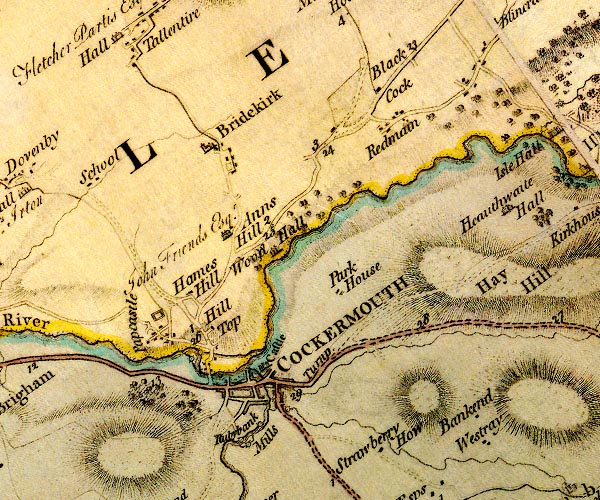




placename:- Derventio
"Site of ROMAN STATION (Supposed to be DERVENTIO)"

D4NY13SW.jpg
square within a square; roman fort at Papcastle
item:- Carlisle Library : Map 2
Image © Carlisle Library
placename:- Derventio
item:- roman coin; coin, roman; fibula; patera
 goto source
goto sourcePage 183:- "..."
"Mr. Routh thus describes the ruins discovered at Pap castle, Jan. 16, 174½(sic)."
""I made particular enquiry of the man in whose grounds they were discovered and of some of the neighbours present at the discovery. The close in which they lay is a little to the south of the fort, on the declivity of the hill to the river, and bounded on the west by a narrow lane, probably the Via militaris continued, and is usually shewn to strangers as the most remarkable here for finding Roman coins."
""These are the largest ruins ever known to be discovered in these parts: for they met with three walls besides the pavement; the first lay east and west and was covered with earth near a foot high: parallel to it at seven yards they found a second, and between these two about two yards deep (the height of the walls, which were six yards broad and strongly cemented), they came to a pavement curiously laid with large flags three-quarters of a yard square and two or three inches thick, as I measured them: but imagining there must be money under it, they covered it up till night, and then tore it all up. It was composed of flags of different thickness: under the thinner was a coarse strong cement which caused them to be broken in taking up, but the thicker are pretty entire. Part of the wall stood on the floor, and the edge was secured by a fine red cement two inches thick, supposed to be intended to keep the floor dry. They imagined themselves at the corner of the building, the third wall standing at right angles with the first, and the second parallel to the stoney lane, on which was an old hedge. On the floor they found a stone trough or rather base of a pillar about a foot high, and the hollowed part square and two inches deep."
""They likewise found a small earthen patera, which I procured, of the fine red clay, beautifully smooth, with letter impressed on the bottom, but so defaced as not to be intelligible. Some years ago, the man's father who found these ruins dug up a conduit. The owner had no coins nor knew of any. One of his neighbours shewed me a large brass one defaced.""
"Mr. Routh in another letter to Mr. Gale April 13, 1743, describes a fibula, a coin of Trajan,... IANO AVG.... P. M. Rev. the emperor seated on a pile of arms, a trophy before him, S.P.Q.R. OPTI... S. C. and two oaken pieces of the adjoining timber of a house which appeared to have been burnt, in the garden of Jerom Tully, esq; of Carlisle. The earth as far as they dug was artificial, and antiquities are only found at a considerable depth."
"Dr. Stukeley says the Roman castrum lies on the top of the hill above the village, and he traced its whole circumference, a bit of the Roman wall by the river side going to Wigton, and there the ditch is plainly visible, though half filled up with the rubbish of the wall. A subterraneous vault, floored with large slabs of freestone, was found in the pasture of the south-east angle. The name of Boroughs includes both closes where it stood, and they find stones and slates with iron pins in them, coins, &c. on the whole spot below it towards the water side. It was a beautiful and well-chosen plan, on the south-west side of a hill, a noble river running under, and pretty good country about it. Coins of Claudius, Adrian, and a silver Geta, PONT. rev. PRINCEPS IVVENTVTIS. He supposes its antient name DERVENTIO derived from the Derwent."
placename:- Pap Castle
placename:- Guasmoric
placename:- Palmecastle
 goto source
goto sourcePage 170:- "..."
"... on the other side the river lies the shell of an old castle called Pap castle, which several monuments prove to have been of Roman antiquity. Whether this was Guasmoric which Nennius says king Vortigern built near Luguballium, and the old Britans called Palmecastle, I do not presume to determine. Among other monuments of antiquity here was found a large vase of greenish stone, ... it now serves at the neighbouring town of Bridkirk, q.d. St. Brigit's church, ..."
 goto source
goto sourcePage 84:- "..."
"[Papcastle] ... above the village is the site of a Roman Castrum, where a great variety of coins, urns, inscriptions, and remains of baths, have been found. It subsequently became the seat of the first lords of Allerdale, before they transferred themselves to the more advantageous position occupied by Cockermouth Castle."
placename:- Derventio
placename:- Derventione
